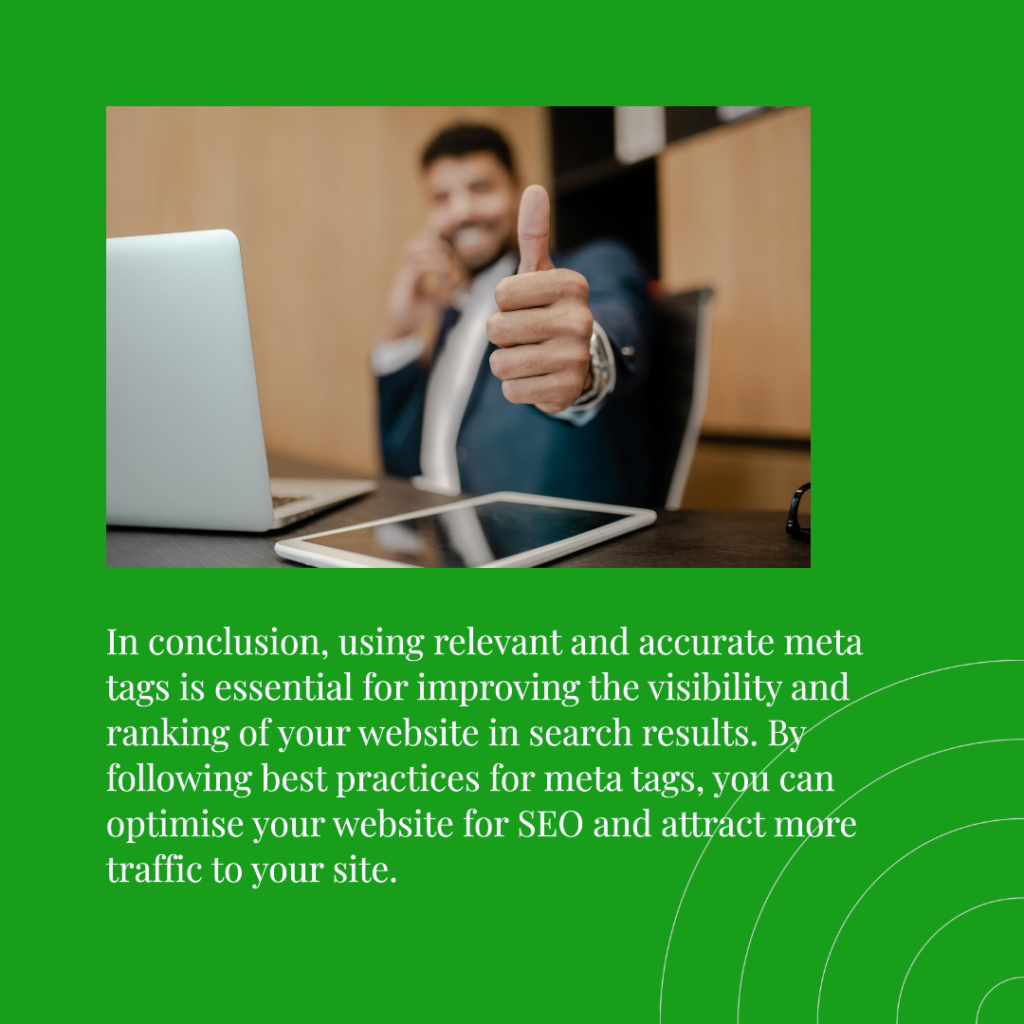Meta Tags for SEO are fragments of HTML code that provide metadata with information about a webpage.

Introduction
Meta Tags don’t appear on the page itself but are embedded in the page’s source code. Search engines use Meta Tags to understand the content and context of a webpage.
Meta Tags for SEO determines a website’s visibility and ranking on search engine results pages (SERPs). These HTML elements provide search engines with important facts about a webpage’s content; they help them get its needfulness to users’ search queries.
Elements of Meta Tags for SEO

Meta Tags for SEO are located within the <head> section of an HTML document and provide findings about the web page’s title, description, keywords, author, and more.
They serve as a roadmap for search engine crawlers, they guide them on how to index and display the webpage in search results. To ascertain the principles of Meta tags is required as it helps to better your website for search engines and improves its visibility online.
Meta Title Tag
The meta title tag, also known as the title tag, is perhaps the most decisive Meta Tag for SEO. It specifies the title of a web page and appears as the clickable headline in search engine results. A well-drafted meta title should be concise, descriptive, and applicable to the content of the page.
It’s recommended to keep the title under 60 characters to ensure it displays properly in search results.
Meta Description Tag
The Meta description tag provides a summary of the content on a web page. While it doesn’t directly influence search engine rankings, a convincing Meta description can entice users to click through to your site from search results. Aim to create a short and attractive description that accurately reflects the page’s content and encourages users to learn more.
Example:
html
Copy code
<meta name=”description” content=”Learn about the mandatory elements of meta tags and how to refine them to reinforce your website’s SEO and visibility.”>
Meta Keywords Tag (Optional)
Once a vital factor of SEO, the Meta keywords tag has diminished in importance over the years. Search engines like Google no longer use it as a ranking aspect due to its vulnerability to keyword stuffing. However, some smaller search engines may still consider it. If you choose to include meta keywords, make them relevant to your content and avoid overuse.
Example:
html
Copy code
<meta name=”keywords” content=”meta tags, SEO, search engine optimisation, website optimisation”>
Meta Charset Tag
The meta charset tag specifies the character encoding for the HTML document. It certifies that the browser renders text correctly, especially for languages with special characters or symbols. The most commonly used character encrypting is UTF-8, which supports a wide range of characters from various languages.
Example:
html
Copy code
<meta charset=”UTF-8″>
Meta Viewport Tag (For Responsive Design)
The meta viewport tag is necessary for creating a responsive web design that adapts to different devices and screen sizes. It controls the width and scaling of the viewport. It sees that your website displays correctly on mobile devices and desktops alike.
Example:
html
Copy code
<meta name=”viewport” content=”width=device-width, initial-scale=1.0″>
To have a clear view of the features of meta tags is needful to refine your website for search engines and upgrade user experience. Well-structured meta titles, descriptions, and other meta tags can enrich your site’s visibility, attract more visitors, and ultimately achieve your online goals.
Keep your meta tags accurate, suitable, and up to date to secure the best possible results.
Types of Meta Tags for SEO

While they might not be visible on the web page itself, Meta Tags for SEO have a significant impact on search engine optimisation, website indexing, and overall user experience.
- Title Tag (Meta Title): The title tag is arguably the most demanding meta tag for SEO. It defines the title of a webpage and appears as the clickable headline in search engine results. It should be brief, descriptive, and contain relative keywords to attract clicks and bolster ranking.
- Meta Description Tag: This tag provides a summary of the webpage’s content. While it doesn’t directly affect listings, a well-composed meta description can entice users to click through to your site from the SERPs. This raises click-through rates (CTR) and indirectly influences listings.
- Meta Keywords Tag: (Deprecated) Historically, this tag was used to specify keywords applicable to the webpage’s content. However, due to abuse and manipulation, major search engines like Google no longer consider it for ranking purposes.
- Meta Robots Tag: This tag instructs search engine crawlers on how to index and display the webpage. It can specify whether to index the page, follow links, or archive content.
- Canonical Tag: The canonical tag is used to address duplicate content issues by specifying the preferred version of a webpage. It helps search engines conclude which URL should be prioritised in search results.
- Viewport Meta Tag: This tag is dynamic for responsive web design. It defines the viewport’s width and scale for proper rendering on various devices. It uplifts user experience and indirectly effects SEO.
Significance of Meta Tags for SEO
To perfect title tags and Meta descriptions reforms a website’s visibility, helps click-through rates, and establishes a strong brand presence online.
While Meta keywords have lost their usefulness, other meta tags continue to play a role in helping search engines understand and rank web pages effectively.
- Better Visibility: Meta tags play a primary role in bettering a website’s visibility on SERPs. A refined title tag and meta description can attract users’ attention and encourage them to click through to the website, increasing organic traffic.
- Promote Click-Through Rates (CTR): A well-designed meta description that accurately reflects the page’s content and appeals to users can result in higher CTRs. When users find the meta description interesting and appropriate to their search query, they are more likely to click on the link.
- Keyword Maximisation: While meta keywords are no longer a significant ranking factor, the title tag and meta description provide valuable opportunities for keyword promotion. To include useful keywords in these tags can help search engines get the content and context of the webpage, it also intensifies its chances of ranking for important queries.
- Differentiation and Branding: Create unique and persuasive meta tags to differentiate a website from its competitors and support its brand identity. A well-created title tag and meta description can convey the value proposition of the website and persuade users to choose it over other search results.
Best Practices: Meta Tags for SEO

Correctly apply these best practices and maximise the effectiveness of your Meta tags, elevate your website’s visibility, click-through rates, and ultimately, its scaling in search engine results.
- Keyword Research: Conduct thorough keyword research to identify meaningful terms and phrases that align with your content and target audience.
- Unique and Descriptive Titles: Write unique and descriptive title tags for each webpage, add primary keywords naturally. Attest readability and importance.
- Convincing Meta Descriptions: Write good meta descriptions that accurately summarise the web page’s content, it entices users to click through.
- Optimal Length: Title tags should typically be around 50-60 characters, while Meta descriptions should be between 150-160 characters. Warrant they display correctly on SERPs.
- Avoid Keyword Stuffing: Do not overload meta tags with keywords, as this can appear spammy and harm your site’s credibility.
- Regular Review and Updates: Continuously observe and update your meta tags to align with changes in your content and SEO plan.
Challenges Facing Meta Tags for SEO
Despite their seemingly straightforward function, meta tags present a series of setbacks that content creators and digital businesses must sail through with finesse.
To cruise past these objections requires a holistic approach that integrates SEO best practices with user-centric principles, technological proficiency, and cultural sensitivity.
Search Engine Optimisation (SEO)
Meta tags play a basic role in search engine optimisation (SEO), they influence a website’s visibility and ranking on search engine results pages (SERPs).
Well-written short meta titles and descriptions that accurately reflect the content of a web page while also adding fitting keywords is a great challenge.
To balance the demands of SEO with the need to attract users requires a delicate equilibrium, as overstuffed or misleading meta tags can result in penalties from search engines.
Evolving Algorithms
Search engine algorithms are in a constant state of evolution, adapting to changes in user behaviour, technological advancements, and emerging trends. To keep pace with these algorithmic shifts poses a formidable problem for content creators, who must continually revise their approach to meta tags to align with the latest best practices.
What worked yesterday may not yield the same results tomorrow, necessitating agility and adaptability in the ever-changing landscape of SEO.
Mobile Improvement
With the increase of smartphones and tablets, to better meta tags for mobile devices has become increasingly important. Mobile users comprise a significant portion of internet traffic, and search engines prioritise mobile-friendly content in their rankings.
To make meta tags that resound with mobile audiences, consider factors such as limited screen real estate and differing search behaviours. This requires you to know mobile enriching schemes.
Multilingual and Multicultural Considerations
Translating meta-tags accurately while preserving their effectiveness across different languages and cultural contexts demands attention to detail. Moreover, accounting for regional variations in search queries and preferences adds another layer of complexity to the localisation process.
Content Management Systems (CMS)
For many website owners, managing meta tags across a sprawling digital ecosystem can be a hard task, particularly when using content management systems (CMS) with diverse templates and modules.
Pledging consistency and coherence in meta tag execution across various web pages, while also accommodating the dynamic nature of content updates requires robust CMS tools and effective workflow management practices.
User Experience (UX)
While meta tags primarily serve an SEO function, they also play a role in shaping the user experience. Meta titles and descriptions serve as the first point of contact between users and search results. They influence click-through rates and engagement levels.
Coming up with meta tags that deliver on the promise of valuable content is necessary as it fosters positive user experiences and builds long-term audience trust.
Conclusion on Meta Tags for SEO

Meta Tags for SEO are indispensable tools for perfecting a website’s visibility and performance in search engine results. Understand their types, significance, and best practices for refinement and harness the power of meta tags to better your website’s SEO and drive organic traffic effectively.
Meta Tags for SEO are important for your business and SEO practices. They may seem small in the grand scheme of website improvement, but their impact on SEO cannot be overstated.
We hope this article helped you learn about Meta Tags for SEO: Best Practices. You may also want to see our guide on On-Page SEO.
If you liked this article, then please subscribe to our YouTube Channel for video tutorials and more. You can also find us on LinkedIn, Twitter and Pinterest.




